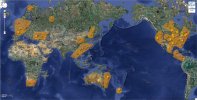An update on the Louisiana Sinkhole.
Oct. 11, 2012
Gas pipleline found floating in giant sinkhole (photo).
http://enenews.com/gas-pipeline-found-floating-on-surface-of-giant-sinkhole-photos
“Emergency response” for butane cavern nearest giant sinkhole — 40-foot high flames seen during flaring — Officials don’t know what happened
[...] Butane burned off early Thursday morning at Crosstex Energy LP’s cavern facility east of the sinkhole, shutting La. 70 South for about 10 minutes, parish officials said.
Crosstex of Dallas has two caverns inside the Napoleonville Dome just east of the sinkhole.
Officials with the parish and the company, Crosstex Energy LP, said Thursday that the flare was not related to the sinkhole but part of normal operations by equipment designed to burn off the gas. [...]
However, the company planned by early Thursday evening to resume flaring through the night to remove butane from lines connected to the caverns and do repairs [...]
Reported to parish officials about 6 a.m., the Thursday morning flare reached a reported 40 feet for about 10 minutes and gradually lowered before going out, Boudreaux said.
Jill McMillan, spokeswoman for Crosstex, said the flaring was an emergency response mechanism related to Crosstex’s Cavern No. 2, which is closer to the sinkhole of the company’s two caverns.
She said company officials are working on why flaring happened.
After the sinkhole’s emergence, Crosstex agreed to move butane from Cavern No. 2 to Cavern No. 1, as a precaution, so the gas is farther from the sinkhole. That process remains under way, she said.
“It’s going as expected,” McMillan said.
This situation began around the same time that the gas pipeline floated to the sinkhole's surface.
*** In this link, a blogger (Paveway111) gives some explaination of the fault line and seismic activity connected to the sinkhole.
http://enenews.com/legal-expert-incredibly-dangerous-situation-louisiana-local-officials-very-concerned-gas-could-burst-ground-explosive-force
Here's the basic model put forth of the seismic connection.
A long, long time ago… the Gulf of Mexico was cut off from the ocean and dried up, leaving behind tens-of-kilometers of salt. Then South America decided it didn't like North America and the two split up, right in the middle of the GOM.
http://oceanexplorer.noaa.gov/explorations/02mexico/background/brinepool/media/gulf_salt.html
Later on the GOM was reconnected with the oceans. The Yucatan sort of spun counter-clockwise, putting little cracks in the big GOM crack.
http://www.aapg.org/explorer/geophysical_corner/2000/gpc10fig2.cfm
Meanwhile, sand and mud and dead dinosaurs piled up on the Louann mother salt. The Louann Basin was squashed towards the south, and a bunch of salt domes poked up where the salt was really thick. That's where the GOM shelf looks like the moon:
http://goo.gl/maps/arnmf
But beneath the Louann salt is a Gulf of Mexico tectonic plate about the same size that's also moving South. All the squishing and movin' south made a fairly active fault along the ancient continental shelf edge.
That fault pretty much connects the Macondo well, Lake Pontchartrain, Baton Rouge, and the sinkhole of death. Further on, the fault runs through Hot Wells LA - where the New Madrid fault may start [/b (=bad)
http://www.aapg.org/explorer/2002/11nov/rift_zone.cfm
Theory: Dead dinos and methane hydrates are not the cause. They're just along for the ride.
*** As for the BP's Macondo well....
Pilot films "substantial amounts of fresh looking oil" around BP's Macondo Reservoir
http://enenews.com/watch-pilot-substantial-amounts-of-fresh-looking-oil-around-bps-macondo-reservoir-photos-video
[...]
MC252 and surroundings, home to BP’s infamous well and the Macondo reservoir. We found what we were looking for, and much that we had hoped not to find.
[...]
What we did not expect was to see that kind of rainbow sheen and substantial amounts of fresh-looking oil around the Macondo reservoir. But find it we did


